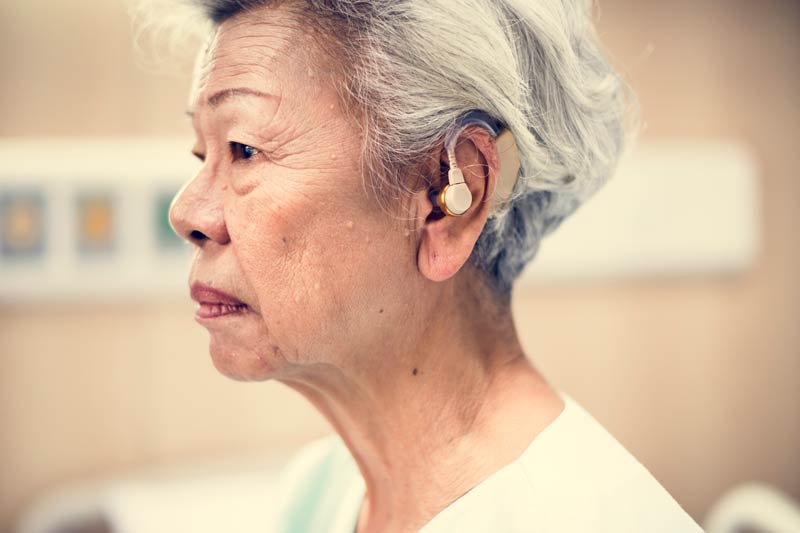How Do Hearing Aids Work?
Hearing aids use the same basic parts to carry sounds from the environment into your ear and make them louder. Most hearing aids are digital, and all are powered with a traditional hearing aid battery or a rechargeable battery.
Small microphones collect sounds from the environment. A computer chip with an amplifier converts the incoming sound into digital code. It analyzes and adjusts the sound based on your hearing loss, listening needs and the level of the sounds around you. The amplified signals are then converted back into sound waves and delivered to your ears through speakers, sometimes called receivers.

What Kinds of Hearing Aids are Available?
Hearing aids come in a variety of sizes and styles, each with its own set of benefits and drawbacks. The smallest and least visible hearing aids are usually the most expensive, but may not provide as much power and amplification as larger models. Here is a brief overview of some of the most common hearing aid styles:
In-the-ear (ITE) hearing aids are custom-made to fit snugly inside your outer ear. They are larger than IIC and CIC aids, but still less visible than BTEs. ITE hearing aids can be easier to handle and adjust than smaller aids, and some models come with special features like directional microphones.
Behind-the-ear (BTE) hearing aids rest outside of the ear, with a tube that runs from the body of the aid into the ear canal. BTEs are larger than other types of hearing aids, but they offer more power and features, making them a good choice for people with severe hearing loss. Many BTEs now come in a variety of colors to better match hair and skin tones.
In-the-canal (ITC) and completely-in-the-canal (CIC) hearing aids are custom made to fit snugly inside your ear canal. ITC and CIC aids are less visible than other types of hearing aids, but they may be more difficult to handle and adjust. These aids also require more frequent cleaning to prevent wax buildup.
Receiver-in-canal (RIC) hearing aids are similar in size and shape to ITC and CIC aids, but the speaker (or receiver) is located outside of the ear canal in a small plastic case that rests behind the ear. RIC aids offer better sound quality than ITC or CIC aids, and some models come with special features like directional microphones.
Pediatric: There are several styles of hearing aids for adults, but children are typically fitted with Behind The Ear (BTE) hearing aids. BTE hearing aids have a casing, which sits behind the ear and houses all the electronics, which attaches over the top of the ear by wire to a speaker, which sits in the ear canal. These hearing aids are the most powerful and effective for relaying consistent, understandable sound. Due to their reliability and power, they are considered the best option for children whose language skills development is a higher priority than cosmetic concerns.
In some cases, especially when a child has very mild hearing loss, an In The Ear (ITE) hearing aid may be recommended. ITE hearing aids are custom made to fit snugly in the ear canal and are less visible than BTE hearing aids. However, they do not provide as much power or clear sound as BTE hearing aids and may need to be replaced more often.
How are Hearing Aids Fit for Me?
Pediatric Hearing Loss
It is essential to get a child with hearing loss immediate treatment. Treatment options will be based on the type, severity, and frequency of your child’s hearing loss. Our team of ENT doctors and audiologists will offer treatment guidelines after learning about your child’s medical history and doing a complete hearing assessment. Early intervention is crucial for children with hearing loss. There are many different types of hearing loss, and it is important to get a correct diagnosis so that the best possible treatment can be provided. Hearing aids are often the most effective treatment for hearing loss, but there are other options available as well.
Choosing a Hearing Aid
If you are experiencing hearing loss, a hearing aid may be a good option for you. But with so many different types and features available, how do you choose the right one?
Here are a few things to consider when selecting a hearing aid:
1. The type of hearing loss you have. There are two main types of hearing loss: conductive and sensorineural. Conductive hearing loss occurs when there is a problem with the outer or middle ear, preventing sound from being conducted to the inner ear. Sensorineural hearing loss is caused by damage to the inner ear (or auditory nerve) and is the most common type of permanent hearing loss.
2. The severity of your hearing loss. Hearing loss is categorized as mild, moderate, severe, or profound. The severity will impact what type of hearing aid is best for you.
3. Your lifestyle and listening needs. Do you work in a noisy environment? Do you enjoy watching TV or going to the movies? Consider how and where you will be using your hearing aid when making your selection.
4. Your budget. Hearing aids range in price from a few hundred dollars to several thousand dollars. Choose the best option for your needs; and be sure to ask about what your insurance covers.
5. The features you want. Today’s hearing aids offer a variety of features, such as Bluetooth compatibility, rechargeable batteries, and directional microphones. Consider which features are most important to you.
6. The size you want. Hearing aids come in a variety of sizes, from completely invisible to larger behind-the-ear models. Choose the size that best suits your needs and preferences.
The audiology team at Texas ENT & Allergy is dedicated to working with you to identify the best solution for your hearing needs. They provide a personalized approach to hearing care to ensure you receive the device and care that meets your lifestyle needs.
Hearing Aid Accessories
There are many different types and sizes of hearing aids, and they can accommodate a variety of add-ons. It might be difficult to determine which, if any, would help you. Ask one of our highly-qualified audiologists about any specific product.
Some of the more popular hearing aid accessories include the following:
- Wireless accessories: Wireless accessories like wireless microphones, remotes and television headsets can help you hear better in situations where there is a lot of background noise or distance between your device.
- Transmitters and receivers: These are helpful in educational situations (a teacher’s words are transmitted directly into the student’s ears) and for children. Transmitters and receivers work together to overcome background noise, distance, and reverberation, contributing to a better learning experience.
- Power adaptors and cords. These add versatility by allowing direct input from various audio sources (FM systems, MP3 players, TVs, and computers). Available with both monaural and binaural cords.
- Earwax filters. Filters prevent earwax, a leading cause of damage to electronic components, from entering the hearing aid. This helps prolong the life of the instrument and provides you with clear, natural sound.
- Cleaning kits. Keeping your hearing aids clean can result in a longer life for your instruments. Cleaning kits give you a leg up on keeping your device in prime working condition. They typically include a wax removal brush and pick, a tube and vent cleaner, battery door opener, and battery replacement magnet.
- Charging stations. For those with rechargeable hearing aids, a charging station is essential. Instead of having to fiddle with the battery compartments, users can simply place their hearing aids in the cradle for a few hours to get a full day’s worth of listening time.
What Hearing Aid Accessories can Benefit Children with Hearing Loss?
There are a number of important accessories that can improve language and learning for children with hearing loss, along with their hearing aids. Classroom-specific hearing aid accessories are commonly used by children and adults alike, as classes and lecture halls can be difficult for those with hearing loss.
For older children who understand their hearing loss, wireless remote control accessories and apps allow for precise hearing aid adjustments without having to touch the tiny and delicate controls on the hearing devices themselves. Other similar accessories can allow your child to wirelessly stream audio from TV’s, computers, and other media players directly to their hearing aids, making it easier for them to follow along.
Some common hearing aid accessories include:
- Wireless remote control accessories and apps
- Wireless streaming accessories
- Volume control knobs
- Hearing aid cases and clips
- Batteries and chargers




















